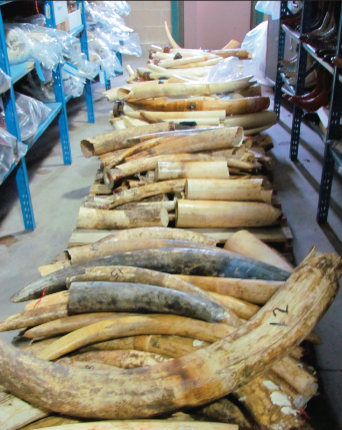US To Crush 6 Tons Of Illegal Ivory In Effort To Stop Elephant Poaching [PHOTO]

In an effort to end the deadly ivory trafficking that claims the lives of some 30,000 elephants every year, U.S. officials plan to crush six tons of ivory seized in the past 25 years by law enforcement.
The move is a first for the U.S. Fish and Wildlife Service, which will pulverize the illegal ivory items on Nov. 14 at the Rocky Mountain Arsenal National Wildlife Refuge in Commerce City, Colo., just outside of Denver, the agency said in a statement.
“The United States believes that it is important to destroy ivory seized as a result of law enforcement investigations and at international ports of entry because elephant poaching in Africa is at its worst in decades and we are committed to protecting elephants from extinction,” the agency wrote in a fact sheet.
The ivory, some of which was smuggled into the country or intercepted while being illegally sold outside the United States, represents the tusks -- and lives -- of at least a couple thousand elephants. While some of the smuggled ivory was found at airports and in cargo ships, other stashes of it were buried in jars of face cream, stained dark brown, or found in display cases at jewelry shops off New York's Times Square.
The illegal ivory trade, which has grown to $10 billion a year, has become a way to finance terrorist networks. More than 30,000 African elephants are killed each year to meet the growing global demand for their ivory tusks.
"This is not the kind of poaching that we have dealt with in the past," Dan Ashe, the director of the Fish and Wildlife Service, told the Guardian. "It's syndicated and sophisticated criminal organizations that are driving the trade."
While the public crushing of the ivory stockpile may send a message to poachers, ending trafficking may also require amending laws.
"The laws need to be changed. They need to be stiffened," David Hayes, a former deputy secretary of interior who was appointed last September to a new White House council on wildlife trafficking, said. "I think that's going to be a primary focus for the advisory council – enforcement penalties, and what we allow and what we don't."
Conservation groups point to decisions made at the Convention on International Trade in Endangered Species in 1999 and 2008 that allowed for limited sales of ivory. This led Zimbabwe to sell 50 tons of ivory in 1997 and China to import 60 tons in 2008. And the demand continues to grow.
"We have seen in Kenya an eightfold increase in poaching since 2009," Paula Kahumbu, chief executive of Wildlife Direct, said. "The volume of ivory being taken across the country is just staggering."
As for the six tons of ivory to be destroyed in the U.S., officials are planning to develop a creative way to use the ivory for educational purposes.
"I believe that the scope and impact of the poaching crisis has now reached the highest levels of the U.S. government," John Webb, a former Department of Justice environmental prosecutor, said. "But, unfortunately, I think it's going to take a huge effort to turn it around this time."
© Copyright IBTimes 2024. All rights reserved.






















